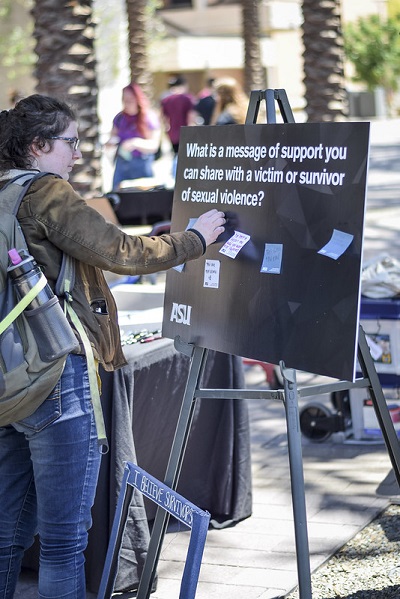6 things you may not know about intimate partner violence

Editor’s note: This article discusses intimate partner violence and abuse.
Do you think you could predict a domestic violence homicide? Do you know that intimate partner violence also has hidden victims?
A series of Domestic Violence Awareness Month events hosted by the Office of Gender-Based Violence at ASU, which has worked with ASU’s Sexual and Relationship Violence Program since 2017 to bring faculty expertise to the student community, will be addressing some of the complexities and effects of abuse.
Denim Day 2019 at ASU
Four virtual events during the month of October will delve deeper into different issues about unhealthy relationships, and Sun Devils are invited to attend. These are a few facts about intimate partner violence that you can learn more about at these events.
1. One-third of U.S. women are victimized by intimate partner violence in their lifetimes, said Professor Jill Messing, who led an informative discussion on the topic at an Oct. 4 event titled Intimate Partner Violence Risk Assessment. Messing is the director of ASU’s Office of Gender-Based Violence.
2. According to the Arizona Coalition Against Sexual and Domestic Violence, about 100 people are killed in domestic violence homicides each year.
“One intimate partner homicide is too many, so I work to identify risk factors for intimate partner homicide and create interventions to prevent this form of serious violence,” Messing said.
3. There are indicators that can help predict intimate partner homicide.
Threats to kill, firearm ownership, strangulation, abuse during pregnancy and extreme jealousy or control are all indicators, said Messing. She said that at the event, she’ll talk about the indicators of homicide risk and how students can use prediction methods.
4. Armed conflict, political instability, forced migration and refugee resettlement can exacerbate intimate partner violence against women, said Assistant Professor Karin Wachter, who is leading the Oct. 25 Intimate Partner Violence in Forced Migration and Refugee Resettlement event.
“Women who seek asylum or resettle to the United States as refugees face specific obstacles seeking help for intimate partner violence. To create inclusivity within the anti-violence movement, awareness of these issues must be part of the conversation,” Wachter said.
5. Children living in households with intimate partner violence who never witnessed the violence have similar outcomes to children who did.
Although it’s clear how violence directly impacts the survivor, there are additional victims, said ASU Assistant Professor Ijeoma Ogbonnaya, who is leading the Oct. 12 session, The Impact of Intimate Partner Violence on Children, Youth and Families.
“I hope that my session will raise awareness about the ‘hidden or silent’ victims, such as children, and how the impact of intimate partner violence can be long-lasting, even if not in a current violent relationship. It is important to be aware of these issues in hidden populations, because they are also in need of help yet might not receive the support they need.”
6. There are both direct and indirect ways that intimate partner violence can impact health and mental health.
Assistant Professor Tina Jiwatram-Negrón examines the types of gender-based violence that occur in marginalized populations of women, including the overlapping risks associated with HIV status, substance use and depression or suicidality. She is leading the Oct. 18 event, Understanding and Addressing the Connections Between GBV and Health and Mental Health Outcomes. She said that Domestic Violence Awareness Month events are important to raise awareness about issues and resources.
“Domestic Violence Awareness Month events help shed light on the issue and introduce different ways that folks can become an advocate or provide support or understanding to someone who may be experiencing violence. It can also help survivors know that they are not alone and potentially connect with needed resources,” she said.
The theme of the 2021 Domestic Violence Awareness Month is healthy relationships, and events are being held throughout October. The ASU Associate Director of Health Initiatives Kimberly Frick said it’s a great benefit to have the support of ASU community experts during this month of action and year-round. The Office of Gender Based Violence provides resources to students such as the myPlan app to help make decisions about abusive relationships as well as collaborate with the Sexual and Relationship Violence Prevention Program on student internship opportunities through Survivor Link.
“It is necessary for researchers and practitioners to work together in order to develop evidence-informed programs to prevent sexual and domestic violence,” said Frick “We are so proud to have experts right here at ASU who are leading the charge to prevent sexual violence and create a safe environment where victims and survivors are supported.”